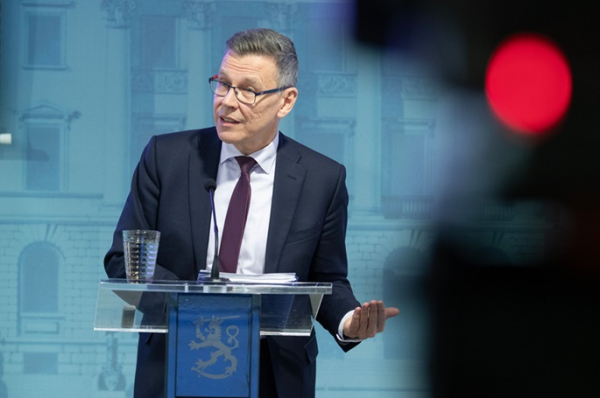Govt forecasts slow growth of Finnish economy due to tariffs

Finland’s economy is recovering from recession, but trade disputes and uncertainty are delaying faster growth, according to the forecast published by the Ministry of Finance on Monday.
Public finances are in dire need of a turnaround, as deficits remain deep and the debt ratio is threatening to rise above 90 per cent, said the Ministry.
Finland’s economy, however, began to grow last year from the lowest point of the recession.
Lower inflation and interest rates have improved household purchasing power, which is also being buoyed by growing employment and tax cuts.
Investments are growing quickly, particularly due to the recovery of the construction industry as well as due to energy transition and defence projects.
Tariffs imposed by the United States, responses to them by other countries and trade policy uncertainties are hindering economic growth.
Finland’s gross domestic product (GDP) is projected to grow around 1.0 per cent this year, 1.5 per cent next year and 1.7 per cent in 2027.
“Despite the uncertainties, there are many positive signs in Finland’s economic outlook. This is good news, because without faster growth Finland’s public finances will not be able to provide the services pledged by the welfare society over the long term,” said Director General of the Ministry Mikko Spolander.
Uncertainty in the global economy has grown significantly as trade policy tensions have heightened. The United States is suffering the most from its own trade policy, with US growth slowing significantly.
Recovery is continuing in the euro area economy, but more slowly than previously projected.
The economic forecast assumes that US import tariffs of around 10 per cent will remain in place.
Finnish export growth is being significantly hindered by US trade policy but is being supported by the euro area recovery. Imports are growing faster than exports, as growth in demand in Finland is being fuelled by investments involving high levels of imported inputs.
Inflation has slowed substantially, and price rises will remain moderate. Consumer prices will rise less than one per cent this year, and inflation will not exceed two per cent in any of the years covered by the forecast. Falling prices of energy and owner-occupied housing have been the main factors bringing inflation down.
With price rises slowing down and wages increasing, real incomes have also returned to growth.
However, the increase in average household real incomes has been slowed down this year by weak employment, cuts in social benefits and increases to consumption taxes.
Real incomes will grow more rapidly next year as the employment situation improves and income taxation drops. In addition to a weak income and employment situation, household consumption has been held back by low confidence in the economy and expectations that prices will continue to rise. However, consumption will begin growing faster next year.
The worst is behind Finland with respect to investments, with a clear increase in the number of investments this year. Housing construction is recovering slowly. The number of housing units being built is still too low to meet long-term needs.
At the same time, investments in the energy transition and technology are growing briskly. A record number of investments are being planned in Finland, and some have already been made this year. These investments include both projects that generate and use clean energy. Investments are also being boosted by defence procurement, which will grow significantly this year as the purchase of new fighter aircraft moves forward. The level of defence procurement will remain high in the coming years.
The decline in employment appears to have halted in the early part of the year. Year-on-year, the number of employed persons is the same as last year, while unemployment is substantially higher, about 9.3 per cent of the labour force. A significant rise in the number of employed persons is expected next year, with unemployment falling to 8.8 per cent. Growth in employment is expected to continue the year after next and the employment rate (age group 20–64) will reach 77.8%.
There is a great deal of potential for employment growth on the labour market, as the labour force has grown substantially over the past few years and returned to significant growth again early in the year. The labour force is growing due to both the Government’s employment measures and immigration. However, this increase has so far shown up as growing unemployment due to weak demand holding employment down.
The starting point for this year was weak, as the general government deficit was 4.4 per cent of GDP last year. Despite faster economic growth and the Government’s adjustment measures, the general government budgetary position will only improve moderately during the forecast period. In particular, central government finances will be weakened by this spring’s decision to cut taxes and increase defence spending in addition to earlier defence procurement decisions.
These divergent factors will lead to a general government deficit of 4.2 per cent of GDP this year, which will gradually improve to around 3.5 per cent in 2027. In 2029, the deficit will be 3.3 per cent of GDP.
The general government debt-to-GDP ratio will exceed 86 per cent this year, after which the growth in debt will slow for the time being.
Deep deficits and insufficient economic growth mean that the debt ratio will continue to grow moderately throughout the forecast period. The debt ratio will exceed 90 per cent for the first time in 2029. If defence spending is kept at about three per cent of GDP and the resulting deficit is not covered, the debt ratio will continue growing after the forecast period.
- Finnish
- Economy
- Slow
- Growth
Source: www.dailyfinland.fi
